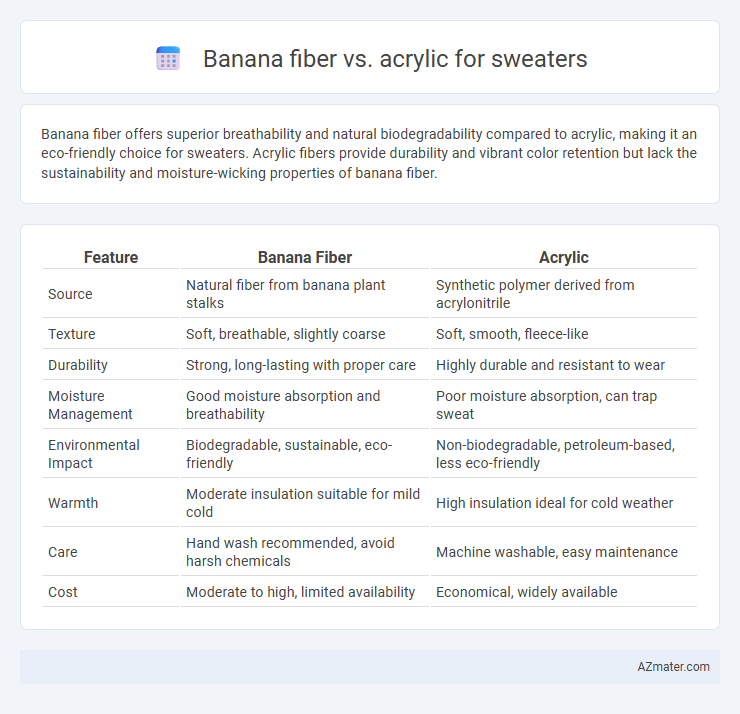Banana fiber offers superior breathability and natural biodegradability compared to acrylic, making it an eco-friendly choice for sweaters. Acrylic fibers provide durability and vibrant color retention but lack the sustainability and moisture-wicking properties of banana fiber.
Table of Comparison
| Feature | Banana Fiber | Acrylic |
|---|---|---|
| Source | Natural fiber from banana plant stalks | Synthetic polymer derived from acrylonitrile |
| Texture | Soft, breathable, slightly coarse | Soft, smooth, fleece-like |
| Durability | Strong, long-lasting with proper care | Highly durable and resistant to wear |
| Moisture Management | Good moisture absorption and breathability | Poor moisture absorption, can trap sweat |
| Environmental Impact | Biodegradable, sustainable, eco-friendly | Non-biodegradable, petroleum-based, less eco-friendly |
| Warmth | Moderate insulation suitable for mild cold | High insulation ideal for cold weather |
| Care | Hand wash recommended, avoid harsh chemicals | Machine washable, easy maintenance |
| Cost | Moderate to high, limited availability | Economical, widely available |
Introduction to Banana Fiber and Acrylic
Banana fiber, extracted from the pseudostem of the banana plant, is a natural, biodegradable textile known for its eco-friendly properties and durability, making it an innovative choice for sustainable sweaters. Acrylic, a synthetic fiber made from polymerized acrylonitrile, offers a lightweight, soft, and warm alternative widely used in conventional sweater manufacturing for its affordability and easy care. Comparing these materials highlights the environmental benefits and unique texture of banana fiber versus the practicality and mass-market appeal of acrylic.
Origins and Production Methods
Banana fiber is derived from the pseudostem of the banana plant, primarily sourced from sustainable agricultural byproducts in countries like India, the Philippines, and Nepal, where the fiber extraction involves water retting and mechanical processes that separate the long strands. Acrylic fiber, a synthetic material invented in the mid-20th century, is produced through the polymerization of acrylonitrile, a chemical compound derived from petroleum, using complex industrial processes such as solution polymerization and solvent spinning. The natural origin and eco-friendly extraction of banana fiber contrast sharply with the petroleum-based synthesis and energy-intensive production of acrylic fibers commonly used in sweater manufacturing.
Environmental Impact Comparison
Banana fiber is a biodegradable, natural material derived from banana plant stems, offering a low environmental footprint through reduced water usage and minimal chemical processing compared to synthetic fibers. Acrylic, a petroleum-based synthetic fiber, contributes to microplastic pollution and has a higher carbon footprint due to energy-intensive manufacturing processes. Choosing banana fiber sweaters supports sustainable fashion by promoting renewable resources and reducing pollution associated with synthetic textiles.
Durability and Longevity
Banana fiber offers superior durability and longevity compared to acrylic for sweaters due to its natural strength and resistance to wear and tear. Unlike acrylic, which tends to pill and degrade faster with repeated washing, banana fiber maintains its structural integrity and softness over time. Sweaters made from banana fiber provide a sustainable, long-lasting alternative that withstands daily use more effectively than synthetic acrylic garments.
Comfort and Skin Feel
Banana fiber sweaters offer superior breathability and natural moisture-wicking properties, making them exceptionally comfortable and gentle on sensitive skin. Acrylic sweaters, while often softer in initial feel, tend to trap heat and moisture, which can lead to irritation or discomfort during prolonged wear. Choosing banana fiber promotes better airflow and reduces the risk of skin irritation, enhancing overall comfort for all-day wear.
Insulation and Warmth
Banana fiber offers natural insulation due to its hollow structure, providing lightweight warmth and breathability ideal for sweaters. Acrylic fibers retain heat effectively and mimic wool's insulating properties, making acrylic sweaters warm but less breathable than banana fiber options. Choosing banana fiber enhances moisture management and eco-friendly warmth, while acrylic ensures consistent insulation durability in cold conditions.
Breathability and Moisture Wicking
Banana fiber exhibits superior breathability compared to acrylic, allowing air to circulate freely and keeping the wearer cool and comfortable. Its natural moisture-wicking properties efficiently absorb and release sweat, reducing dampness and odor during wear. Acrylic, being synthetic, tends to trap heat and moisture, making banana fiber a more breathable and moisture-managing option for sweaters.
Maintenance and Care Requirements
Banana fiber sweaters require gentle hand washing with mild detergent, avoiding harsh chemicals to preserve the natural fibers and prevent fraying, while air drying is essential to maintain their shape and durability. Acrylic sweaters are more resilient and machine washable, often allowing for tumble drying on low heat, making them easier to care for daily without significant risk of shrinking or damage. Proper maintenance of banana fiber involves more delicate handling compared to acrylic, which offers greater convenience and longevity under frequent washing.
Market Availability and Cost
Banana fiber sweaters are emerging in niche markets with limited availability due to the complex extraction process and lower production scale compared to acrylic, which dominates mass-market sweater production. Acrylic sweaters offer widespread accessibility in various retail outlets at a significantly lower cost, driven by synthetic fiber manufacturing efficiencies. The price difference reflects banana fiber's eco-friendly appeal and artisanal production, positioning it as a premium sustainable alternative to cost-effective, widely available acrylic options.
Final Verdict: Which is Better for Sweaters?
Banana fiber sweaters offer superior breathability, natural moisture-wicking properties, and eco-friendly sustainability compared to acrylic, which is synthetic, less breathable, and prone to pilling. The natural antibacterial qualities of banana fiber also enhance comfort and reduce odor, making it ideal for sensitive skin and all-day wear. For durability, softness, and environmental impact, banana fiber is the better choice for sweaters.

Infographic: Banana fiber vs Acrylic for Sweater
 azmater.com
azmater.com